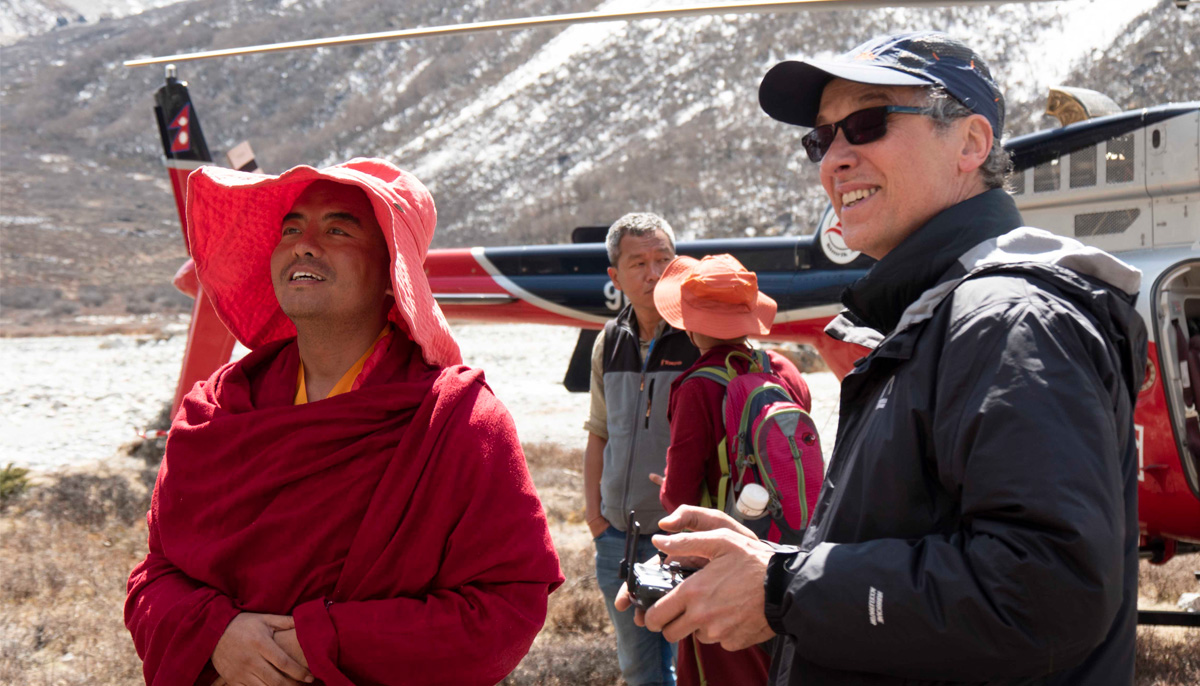Martine Panzica: Wandering…But Not Lost tells the story of Mingyur Rinpoche’s remarkable four-and-a-half year journey as a wandering yogi. Was it challenging to tell the story of such an extended and profound voyage?
Paul MacGowan: Well, it was very challenging, as you can imagine, because all the action had happened. So I’m filming after the fact. When he came back, we met in Delhi. He didn’t have much to say about his retreat yet. But over the following weeks, there were a number of us who were kind of tagging along. He was teaching and visiting folks, and slowly, the stories of his retreat started coming out. Everybody was saying, “Tell us more, tell us more, tell us more!” I had no idea at first that this would be another film. But the stories were just so inspiring and so compelling that I wanted to make this film.
He’s a good storyteller. I said, “You tell the stories, and I’ll show these places.” And so he said, “Yeah, okay. Good idea.” I was really excited — but then it became so much more.
It’s really challenging to make it a compelling story when the action has already happened. I had no footage. But he was so easy to work with, and he knew I wanted to get shots of him in the mountains. To just go and to be with Rinpoche in these places, it was kind of relaxing. It was a bit of a whirlwind in one sense, but we could be there and in this beautiful environment.
The documentary showcases some stunning cinematography, including views of the Himalayan mountains, rivers, and valleys. What was it like filming these locations?
I absolutely love the mountains. I wanted to tell Rinpoche’s story in a genuine, authentic way. He is such a genuine person, sharing his struggles. So it’s kind of related, wanting to do a good job telling his story and also showing these absolutely stunning mountains and landscapes, and doing it when you’re kind of exhausted while trekking.
When I heard Mingyur Rinpoche was going to do this retreat, I doubled my practice overnight. I was just so inspired by it.
I’m no spring chicken anymore. I used to run up mountains but now I’m slowing down in my 60s. It was challenging. But the whole time, with the friends that came with me, we just decided to treat it like a pilgrimage. We knew Rinpoche had been on retreat in these locations. Wherever we were, we just felt like it was really a special time.
The interviews with Mingyur Rinpoche in the film provide detailed insights into his thought process and physical experiences during the challenges of his journey. How did you get him to tell these stories?
Fortunately, I had a lot of experience working and filming with him, so that helped a lot. I probably did about a dozen interviews with him to get all the information factually correct. But it was an interesting experience. His memory is so good and he was willing to share, but there were times when he was kind of vague.
It took me a while to figure out what was going on. His memory is so sharp, and I didn’t feel like he was holding back, but eventually, I thought: Oh, he was practicing. He wasn’t on a vacation, keeping a travelogue of his experiences. He was, for lack of a better phrase, “in the moment.” He wasn’t thinking about how he would tell the story later. So that was kind of a revelation for me.

Given that this film covers a wide span of time, geography, and subjects, including encounters with individuals along Mingyur Rinpoche’s journey, were there any highlights or favourite moments that you recall during the production process?
It took me five years to make the film. I have to say it was in the mountains with Rinpoche. After figuring out the timing, finding the money, arranging the helicopter, I was worried about the weather. I was worried about a million things and the weather was absolutely perfect. To be there with Rinpoche was just really special. You can just tell that he just enjoyed being back there. It was just a really special time.
I’m a planner. When I learned how to make a good video in America, I learned that you have to control everything. You control the lighting, the sound, the people, the crew — every aspect of it to get a good end result. In India and Nepal, you’re not in control of anything. It’s like total chaos thrown into the mix. You’re making a documentary, so you kind of have to capture what you’re getting. But it’s the places and the people that made it interesting.
While the film primarily centers around Mingyur Rinpoche’s solitary journey, it also presents a larger story about our ability to practice mindfulness in everyday life, regardless of location. What do you hope viewers will take away from watching the film?
I hope they’re inspired by it to practice. When I heard Mingyur Rinpoche had announced he was going to do this retreat, I doubled my practice overnight. I was just so inspired by it. I’m hoping people are inspired by what he did. I hope they learn more about how to bring challenging situations into their practice. That’s what Rinpoche really wants people to do. He’s obviously not suggesting anybody does this kind of retreat. What I practice with here in Kathmandu is working with minor annoyances. You might be able to hear the dogs barking outside, or the cafe and nightclub down below that’s always playing music. We can work with these minor annoyances on the path — we don’t have to think that we have to accomplish this big thing. We just work with these small things on a daily basis, and that can make a profound change.
I also hope people see Mingyur Rinpoche for the great teacher that he is. We’re just fortunate to have these teachers like Mingyur Rinpoche who we can study with and learn from.

